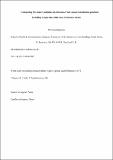Files in this item
Comparing the cancer potencies of emissions from vapourised nicotine products including e-cigarettes with those of tobacco smoke
Item metadata
| dc.contributor.author | Stephens, William E. | |
| dc.date.accessioned | 2017-08-10T13:30:11Z | |
| dc.date.available | 2017-08-10T13:30:11Z | |
| dc.date.issued | 2017-12-18 | |
| dc.identifier | 250713926 | |
| dc.identifier | ebab24ee-205b-4dce-87f0-6729b5be2bb9 | |
| dc.identifier | 28778971 | |
| dc.identifier | 28778971 | |
| dc.identifier | 85041702634 | |
| dc.identifier | 000418198900004 | |
| dc.identifier.citation | Stephens , W E 2017 , ' Comparing the cancer potencies of emissions from vapourised nicotine products including e-cigarettes with those of tobacco smoke ' , Tobacco Control , vol. 21 , no. 1 , pp. 10-17 . https://doi.org/10.1136/tobaccocontrol-2017-053808 | en |
| dc.identifier.issn | 0964-4563 | |
| dc.identifier.other | ORCID: /0000-0002-0884-8722/work/65013901 | |
| dc.identifier.uri | https://hdl.handle.net/10023/11421 | |
| dc.description | © Article author(s) (or their employer(s) unless otherwise stated in the text of the article) 2017. All rights reserved. No commercial use is permitted unless otherwise expressly granted. | en |
| dc.description.abstract | Background Quantifying relative harm caused by inhaling the aerosol emissions of vapourised nicotine products compared with smoking combustible tobacco is an important issue for public health. Methods The cancer potencies of various nicotine-delivering aerosols are modelled using published chemical analyses of emissions and their associated inhalation unit risks. Potencies are compared using a conversion procedure for expressing smoke and e-cigarette vapours in common units. Lifetime cancer risks are calculated from potencies using daily consumption estimates. Results The aerosols form a spectrum of cancer potencies spanning five orders of magnitude from uncontaminated air to tobacco smoke. E-cigarette emissions span most of this range with the preponderance of products having potencies<1% of tobacco smoke and falling within two orders of magnitude of a medicinal nicotine inhaler; however, a small minority have much higher potencies. These high-risk results tend to be associated with high levels of carbonyls generated when excessive power is delivered to the atomiser coil. Samples of a prototype heat-not-burn device have lower cancer potencies than tobacco smoke by at least one order of magnitude, but higher potencies than most e-cigarettes. Mean lifetime risks decline in the sequence: combustible cigarettes >> heat-not-burn >> e-cigarettes (normal power)≥nicotine inhaler. Conclusions Optimal combinations of device settings, liquid formulation and vaping behaviour normally result in e-cigarette emissions with much less carcinogenic potency than tobacco smoke, notwithstanding there are circumstances in which the cancer risks of e-cigarette emissions can escalate, sometimes substantially. These circumstances are usually avoidable when the causes are known. | |
| dc.format.extent | 8 | |
| dc.format.extent | 821681 | |
| dc.language.iso | eng | |
| dc.relation.ispartof | Tobacco Control | en |
| dc.subject | RA Public aspects of medicine | en |
| dc.subject | RA0421 Public health. Hygiene. Preventive Medicine | en |
| dc.subject | RC0254 Neoplasms. Tumors. Oncology (including Cancer) | en |
| dc.subject | NDAS | en |
| dc.subject | BDC | en |
| dc.subject | R2C | en |
| dc.subject | SDG 3 - Good Health and Well-being | en |
| dc.subject.lcc | RA | en |
| dc.subject.lcc | RA0421 | en |
| dc.subject.lcc | RC0254 | en |
| dc.title | Comparing the cancer potencies of emissions from vapourised nicotine products including e-cigarettes with those of tobacco smoke | en |
| dc.type | Journal article | en |
| dc.contributor.institution | University of St Andrews. School of Earth & Environmental Sciences | en |
| dc.contributor.institution | University of St Andrews. School of Geography and Geosciences | en |
| dc.identifier.doi | https://doi.org/10.1136/tobaccocontrol-2017-053808 | |
| dc.description.status | Peer reviewed | en |
This item appears in the following Collection(s)
Items in the St Andrews Research Repository are protected by copyright, with all rights reserved, unless otherwise indicated.

